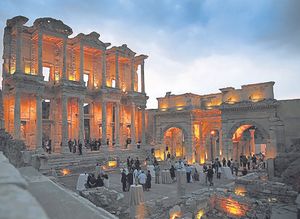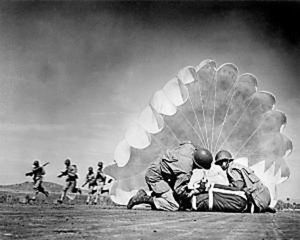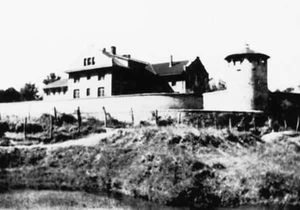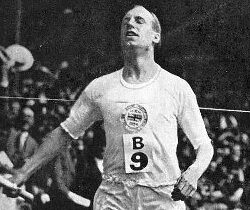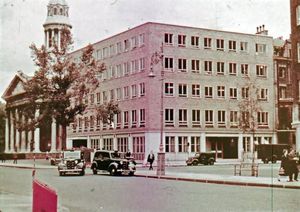T. C. Hammond (1877-1961)
At the age of 13 he started work as a railway clerk in Cork, Ireland. Forty-six years later he became an outstanding principal of Moore Theological College, Sydney, Australia.
But there is much more to the remarkable life of T. C. Hammond.
‘Tommy’ Hammond was born into a Protestant family in Cork in 1877. His father died when he was only six years old. In those days women did not attend funerals, so he was put into a carriage and went on his own.
Around the time he began work, he joined the newly formed YMCA in Cork. This met originally in the first Soldiers’ Home opened by Elsie Sandes. Prominent in the YMCA was John McNay, who gave himself tirelessly to the boys and led them in Bible studies.
Conversion
Along with Hammond in McNay’s Bible study group were the Wood brothers who later started the Young Life Campaign. Hammond was probably converted in 1892, after ‘three miserable months’.
He soon joined in open air street preaching, a hazardous occupation in those times. Armed police would arrive in Cork each Saturday evening in anticipation of riots at the preaching!
When he was 18 he entered the Irish Church Missions (ICM) training school in Dublin. The ICM is a Church of Ireland mission, mainly to Roman Catholics. The course in the training school included subjects like grammar, geography and mathematics, as well as spiritual subjects.
Hammond studied hard, aided by an almost photographic memory, and learnt the importance of getting his facts and references correct. From 1897-1899 he was sent out with an experienced worker for several weeks at a time, evangelising throughout southern Ireland. They went to markets and fairs, preaching and selling literature.
Two important events took place in 1900. First, he entered Trinity College, Dublin, in order to enter the Church of Ireland ministry. Second, he became engaged to Margaret McNay, the sister of John McNay, though they were not able to marry until 1906.
There is no doubt that through the years he owed a great deal to his wife. As is so often the case, there is little mention of her in his life story. Much later, when they were asked to list their hobbies, he put ‘reading, badminton, chess’, while she wrote ‘looking after hubby’!
Career
At Trinity he studied philosophy, ethics and logic, subjects in which he excelled. They enabled him to think clearly and critically. At the end of 1903 he was appointed curate in St Kevin’s Church, Dublin. His first sermon was on the text ‘Woe is unto me, if I preach not the gospel’.
The rector was elderly and his health failing, so much of the burden of parish work fell on Hammond’s shoulders. In 1910 he became rector himself, when his predecessor retired. He proved an indefatigable worker. On a wider front, he was concerned to resist ritualism and theological modernism within the Church of Ireland.
In 1919 Hammond was chosen as Superintendent of the ICM. This was an extraordinarily difficult time for Irish Protestants. It was the beginning of an Irish war of independence leading to the establishment of the Irish Free State. Sinn Fein snipers fired from his roof, which brought his home under attack from the British.
Both sides used Hammond as an intermediary and he was on an IRA hit-list, being spared because he helped people regardless of their religious beliefs. On one occasion a bullet tore the sleeve of his coat.
When Hammond addressed ICM workers he gave them this advice: ‘Get a sense of humour or get out of Christian work. Without a sense of humour, it will be the death of you!’
He himself had a very Irish sense of humour, describing himself as ‘a lightweight speaker, being a man of Cork’!
There was much administrative work, with schools and children’s homes to oversee. Against some opposition he opened a home for children born out of wedlock. In its first 15 years 461 children were admitted.
Ministry
He continued to engage in the open air ministry of the mission in Dublin, and was particularly noted for the ‘contros’. These were ‘controversial meetings’, always held on mission premises, dealing with some aspect of Roman Catholic teaching.
When notable Roman Catholic speakers came to lecture in Dublin, one of the senior workers of the mission would attend and take notes. These were passed to Hammond, who would respond to the speaker later in the evening, the meeting being advertised by men with sandwich boards.
During the 1920s there was considerable pressure to revise the 1662 Prayer book and introduce more Catholic practices. In response, Hammond was asked to give a series of lectures on the subject. This resulted in a tour which kept him away for nearly a year.
He travelled across Canada to Vancouver, and then on to Australia. It was as a result of this lecture tour that he was invited to become Principal of Moore College in Sydney.
When the vacancy arose, the impression his visit had made years earlier was remembered. His farewell meeting in Dublin took place on 20 February 1936. He took up his post at Moore in April, at the age of nearly 60. As if he hadn’t enough to do, he also became rector of St Philip’s Church at the same time.
Marcus Loane, his vice-principal, later to become Archbishop of Sydney, said: ‘The arrival of T. C. Hammond in Sydney in 1936 marked the beginning of a new era with the impact of strong evangelical theology’.
An early lecture on the transcendence of God left students reeling. Although he lectured on most subjects in the college curriculum, he excelled in dogmatic theology.
He put the college on a sound footing, improving and enlarging its buildings. He also involved himself in the affairs of the diocese, resisting liberalism and ritualism.
Integrity
On Sunday nights T. C. Hammond gave broadcast talks, often explaining the differences between Protestant and Roman Catholic teaching. On the day he died, his son found open on his father’s desk a Latin volume by the sixteenth century Catholic theologian, Robert Bellarmine. He practised what he taught his students — ‘define your terms and verify your references’.
Leon Morris said of him: ‘His work at Moore College gave that institution much of its present direction and established it as a bastion of evangelicalism and as a place of first-rate scholarship’. On a more personal note he wrote: ‘He taught me to concentrate on the evidence rather than on scholarly opinion and he was merciless in exposing illogicality and bluster’.
Hammond was the author of a number of books and many booklets, as well as regularly contributing to several periodicals. Two books must be mentioned. The first is In understanding be men, a basic handbook of Christian doctrine.
This was originally intended for students in general after a mission to London University. It sought to be both brief and comprehensive. As it was written just before he moved to Australia — he checked the proofs on the boat — he was given assistance by Douglas Johnson of IVF. Appearing in 1936, it was revised in 1968 and remained in print until the 1990s.
From about 1850, the Irish Church Missions used 100 texts from the Bible as a teaching aid in its schools to show the difference between the Bible and Roman Catholic doctrine.
A commentary on these texts was first issued in 1883. In 1939 Hammond produced a revised and expanded version of The one hundred texts. This includes considerable reference to Roman Catholic teaching and books.
Godliness
It is a remarkable piece of work and went through at least six editions. The Catholic Church is one of the major threats to the gospel at present. When will another Hammond arise, with a thorough, cogent response to its teaching?
He was not just a controversialist, though he believed that was a necessary part of his ministry. His great concern was the biblical gospel which he preached and taught.
He knew his Bible so well that once, when the lights went out as he was reading a chapter, he simply carried on. During his time at ICM some 500 people professed conversion, which is remarkable in the circumstances of those days in Ireland.
His work at Moore College is surely his greatest legacy. The evangelical ethos and educational excellence he established has continued down the years.
Hammond retired from Moore College in 1953, at the age of 76, but not from St Philip’s. He once remarked: ‘When I retire, my widow will live with my daughter’.
On Sunday 12 November 1961, in giving out the notices, he added: ‘These apply to you, but they won’t apply to me’. On the following Wednesday he had a cerebral haemorrhage and was taken to hospital. He regained consciousness, thanked the doctors and then said simply, ‘I’m going now’.
Bunyan would surely have added: ‘And all the trumpets sounded for him on the other side’.
Paul E. Brown


